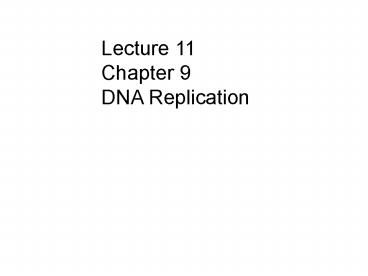DNA Replication - PowerPoint PPT Presentation
1 / 29
Title:
DNA Replication
Description:
Replication = 'duplication of DNA. giving rise to a new ... Stahl. isotopes. Replication. is bidirectional. Replication. forks. Origin. One strand is formed ... – PowerPoint PPT presentation
Number of Views:35
Avg rating:3.0/5.0
Title: DNA Replication
1
Lecture 11 Chapter 9 DNA Replication
2
The flow of genetic information in the cell.
Replication
3
Replication duplication of DNA giving rise to
a new molecule of DNA with the same base
sequence as the original cell division
4
Biological problem need extreme fidelity. Put
in the wrong base ? mutation. Proofreading.
5
The flow of genetic information in the cell.
Transcription
6
Transcription Synthesis of an mRNA (messenger
RNA) using the DNA template.
7
The flow of genetic information in the cell.
Translation
8
Translation Synthesis of proteins using the
mRNA as a template. 3 bases codes for 1 amino
acid
9
The flow of genetic information in the cell.
DNA ? RNA ? protein
10
The flow of genetic information in the cell.
RNA viruses
Retroviruses such as HIV Reverse transcriptase
11
- Challenger for the replication process
- Separate the two strands -
- Protect the unwound strands from
- nucleases.
2. DNA must be synthesized from 5 to 3.
- Protect against errors during
- synthesis.
12
DNA is synthesized semi-conservatively. Each
newly-synthesized DNA molecule contains 1new
strand and 1 old one.
13
Semi- conservative replication
Meselson Stahl isotopes
14
(No Transcript)
15
Replication is bidirectional
Origin
Replication forks
16
One strand is formed disconinuously.
Leading strand continuously
Lagging strand discontinusously
Okazaki fragments put together with a
ligase.
17
DNA polymerase catalyzes the addition of each
new nucleotide to the growing chain.
18
Nucleophilic attack
New phosphodiester bond
Nucleophile that will form the next bond.
19
(No Transcript)
20
DNA polymerase III
1. Needs a primer which is RNA
2. Has 3 exonuclease activity proofreading
like a backspace key
21
SSB single strand binding protein
Replication fork
DNA gyrase
Helicase
22
Replication fork
DNA polymerase III
23
Replication fork
RNA is the primer synthesized by primase
24
The primer is removed by DNA polymerae I and
replaces the primer with deoxynucleotides.
25
Table 9.3 Summary of DNA Replication
- DNA synthesis is bidirectional. Two
- replication forks advance in opposite
- directions from an origin of replication.
26
2. The direction of synthesis is from the 5
to the 3 end of the newly synthesized
strand. One strand (the leading strand) is
formed continuously, while the other strand
(the lagging strand) is form discontinuously
On the lagging strand, small fragments of
DNA (Okazaki fragments) are subsequently
linked.
27
- There are 5 polymerases. Polymerase III
- is primarily responsible for the synthesis
- of new strands. Polymerase I is involved
- in synthesis, proofreading and repair.
28
- DNA gyrase introduces a swivel point
- in advance of the replication fork.
- A helicase promotes unwinding.
- SSB stabilizes the single DNA strand.
- Primary catalyzes the synthesis of the
- RNA primer.
29
6. DNA polymerase I removes the primer and
replaces it with deoxynucleotides. DNA ligase
seals the remaining nicks.































